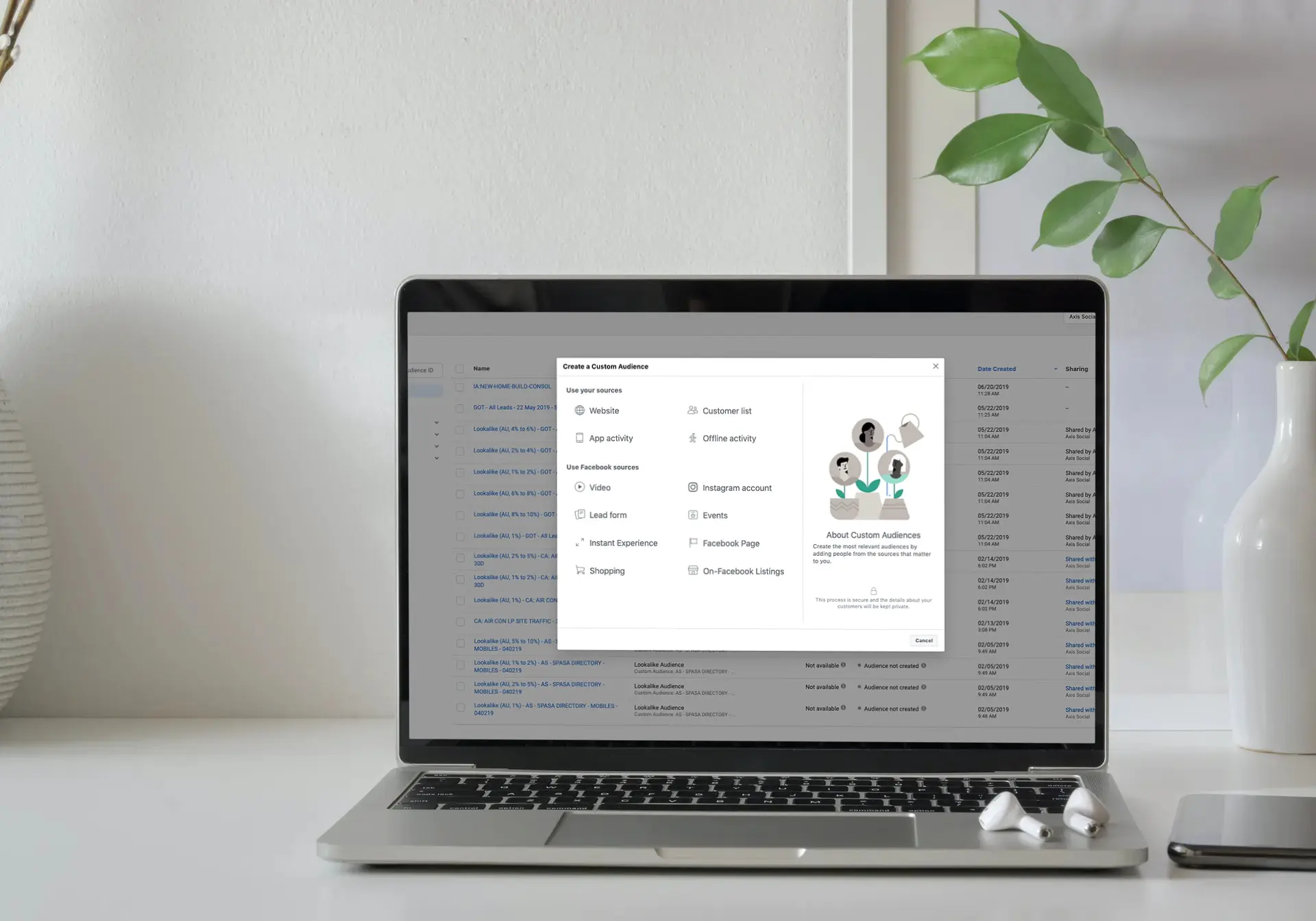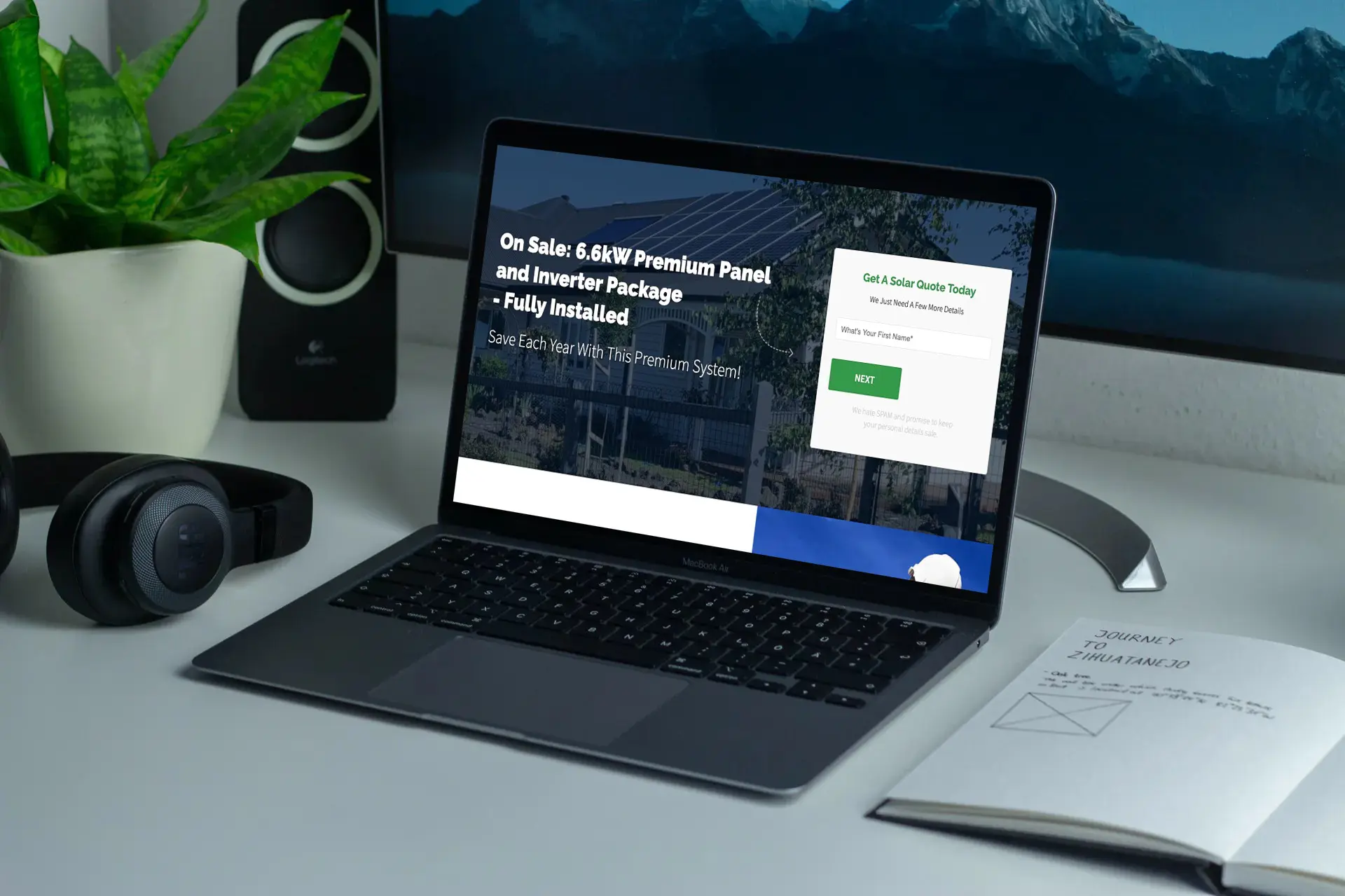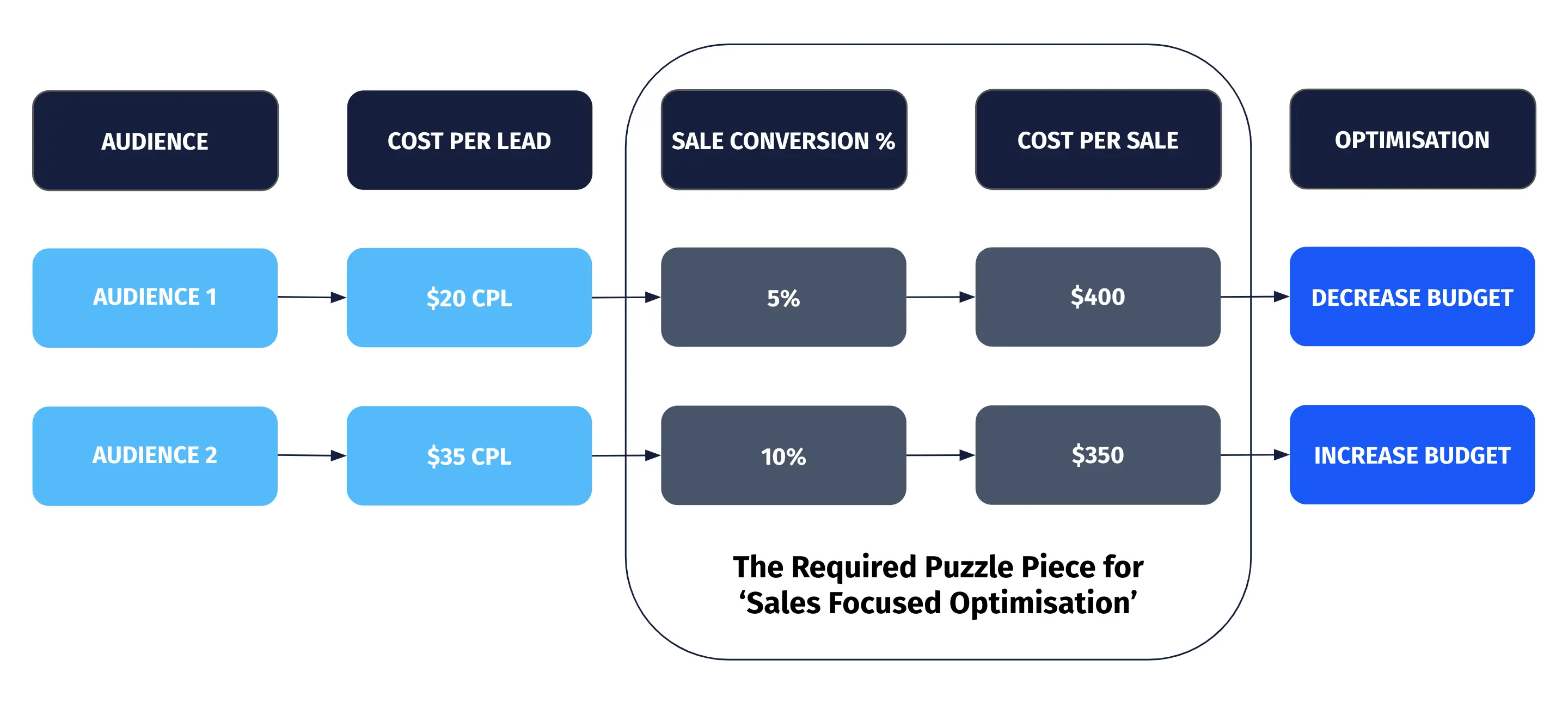Leads or sales…
Which one is your Facebook Ads campaigns designed to deliver?
It may seem like an odd question.

“Leads!” I can hear you shout. “The more leads we receive, the more sales we can generate!”
And if campaign budgets and sales team members’ time was infinite, then it would be that simple.
Yet, we all know this isn’t the case.
In fact, increasing the number of low intent leads a sales team has to qualify will HURT your campaign ROI, not help it.
In contrast, a sales-focused campaign is designed to maximise ROI.
It is designed to generate sales-qualified leads with an intent to buy, all while putting the sales team in a position to win more deals.
So, what makes a campaign designed for sales, not just leads?
These are the 5 things that you need to do if you want your campaign to deliver sales, not just leads.
1. Feed Your Targeting Sales Data, Not Just “Leads”
When we win a new client, one of the first things we review is their current audience targeting.
More often than not, we uncover audience targeting focused on generating low-cost leads.
This may be the exclusive use of broad interest audiences, or Lookalike audiences build on Website Traffic or Lead Events.
At first glance, the Cost Per Lead for some of these audiences might look good.
But, when we dig deeper and analyse the Lead to Sale ratios of these audiences, things take a turn for the worst.
In many instances, those audiences generating the highest volume of low cost leads are often those with the worst conversion rate.
We’ve dedicated an entire blog post to this issue here along with the process we use to uncover the TRUE top-performing audiences.
Rarely do we come across targeting which is routinely updated with sales data.
Think about your campaigns for a minute…
When was the last time you created a lookalike audience of quoted or converted customers?
If the answer is “more than 3 months ago”, your campaigns aren’t primed for sales.
To feed your campaign sales data, make sure that you’re regularly updating your audience targeting with customer or quote lists. We’d recommend that this occurs between monthly or quarterly depending on sales volume and sales cycle.
Test the impact of excluding non-contact or quote-lost lookalikes from your targeting. This can help remove the lower quality, “tyre kicker” leads from your team’s pipeline.

2. Match Your Offer To Your Desired Lead Temperature
Does your campaign currently using a “Get A Quote” offer?
If so, I’d bet your sales team complain of a pretty mixed bag of leads when it comes to readiness to buy.
And it makes sense. Requesting a quote makes it difficult to determine if a prospect is ready to buy, or is doing initial research.
This approach is fine if your sales team is happy to continue to deal with a mixed bag of leads.
However, if you’re looking for a higher level of intent from your leads, your offer needs to appeal to those ready to buy.
In our experience, these offers usually contain a financial incentive for immediate action.
Some examples include:
- Get $1,000 Off A Premium System When You Buy This Month.
- Get 72 Months Interest Free & No Deposit Across Our Range.
- Get A Free Upgrade When You Book An Install Before June 30.
These type of offers will appeal to those prospects who have made the shift from consideration to actively shopping. They are already convinced they want to make a purchase within the category. Now they are looking for a great deal and a supplier they can trust.

These are the “ready to buy” leads you want more of if you want a campaign designed for sales.
3. Use Your Form To Position Your Sales Team For Success.
For most homeowner lead generation campaigns, the questions asked on an enquiry form are an afterthought.
Little attention is paid to how the questions you ask will influence the sales follow up and the prospect’s perception of the organisation.

For example – let’s say you were interested in getting solar installed at your home. You’ve shortlisted 2 different installation companies that you think would do a great job.
For Installer A, you were asked to provide your name, email and phone number.
For Installer B, you were asked to provide your name, email, phone number, street address along with an estimate of your quarterly energy bill.
Which sales team do you think will be in the best position to provide you with a customised quote and pitch?
Which sales team do you think would record a higher percentage of qualified leads?
Which sales team do you think would be able to score your enquiry and prioritise it against other leads they received that day?
Now there is undoubtedly a need to balance the number and types of questions you’re asking with the impact on your landing page conversion rate.
For some campaigns, adding extra questions will only lead to an increase in the Cost Per Lead.
But the key takeaway here is that deciding what to ask on your form is a key component of designing a campaign for sales.
Don’t treat it as an afterthought.
4. Design Your User Journey To Nurture & Close Leads.
So far, everything that we’ve covered has been focused on getting the initial enquiry.
But a campaign designed for sales, not just leads, continues to work even after the prospect has enquired.
This is because once a prospect submits an enquiry, they will instantly shift into evaluation mode.
They will be analysing every touchpoint with your business to determine if you’re the right solution for their needs.
And while the heavy lifting now will be done by your sales team, there’s still plenty your campaigns can do to help nurture and close leads.
You can do this by ensuring that your retargeting includes those who have recently entered your sales pipeline.
Depending on volume, you may be able to segment based on recency of enquiry and deal stage.
For a campaign designed for sales, you want to ensure that you’re retargeting prospects with the following ads:
- Customer Testimonials: Break down any lack of trust by showing consistent success for other customers.
- Why Choose Us?: Prospects active in the category will likely be evaluating you against your competitors. Clearly spell out the specific reasons why you are the best choice.
- What Happens Next?: Some prospects may feel daunted by what happens post-enquiry. Break down this barrier by clearly outlining what happens after their enquiry.
- FAQs: It’s likely that prospects share the same questions or concerns about buying in your category. Answer these within the ad to provide confidence that your team is THE expert in the category.

5. Measure Cost Per Sale, Not Cost Per Lead.
The final component of a campaign designed for sales is the most important.
Make sure that you’re evaluating your campaigns based on Cost Per Sale, not Cost Per Lead.
This is simple to understand, but harder to implement.
It is vital however to ensure that you’re focused on the most important measure when it comes to optimising and evaluating your campaigns.
Some tactics that will improve lead quality may lead to an increase in Cost Per Lead but a decrease in Cost Per Sale. These could include qualifying ad creative or adding questions to your forms.
If you’re not evaluating your campaigns based on Cost Per Sale, you’ll likely throw these tactics away.
This process of Sales Focused Optimisation is so important that we’ve dedicated an entire post to it. You can find it here.

In summary, if you want a campaign designed for sales, you need to be measuring what truly matters.
Wrapping It Up
It’s easy to fall into the trap of evaluating your campaigns based on lead volume and Cost Per Lead.
But when it comes to maximising the ROI of your media spend and sales team, the best campaign approach is one build for Sales, not just Leads.
These are the 5 things that you need to do if you want your campaign to deliver sales, not just leads.
1. Feed Your Targeting Sales Data, Not Just “Leads”
2. Match Your Offer To Your Desired Lead Temperature
3. Use Your Form To Position Your Sales Team For Success.
4. Design Your User Journey To Nurture & Close Leads.
5. Measure Cost Per Sale, Not Cost Per Lead.

